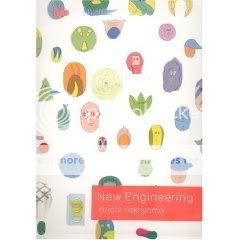New Engineering
Yuichi Yokoyama, writer/artist
PictureBox, 2007
232 pages
$19.95
Copies of New Engineering should be automatically sent to any comics artist who draws action for a living, through the mail, courtesy of state or local authorities, in much the same way that Billy Joel’s Greatest Hits is issued to all Long Island residents when they reach age 10. It’s just something they’re going to need if they want to keep up.
Unfettered by plot or character considerations as such, Yokoyama’s comics are pure action: combat and construction most memorably, but also travel and some sort of bizarre approximation of automation. With a no-nonsense line Yokoyama follows objects in motion, allowing layout within each panel and on each page to be dictated simply by the inherent length of each action beat rather than any kind of human or emotional component. The result is an always fresh, frequently thrilling approach to choreographing and staging the movement of physical bodies through space.
In battle comics like “Book” and “Model Room,” Yokoyama frequently captures his combatants and their weaponry at the vertex of their movement–that moment at the top of the roller coaster where you’re about to shift from tilting forward to tilting backward. The view constantly shifts to show us the most exciting possible vantage point, allowing thrown objects (or people!) to guide us to a new vantage point within the space. (Think of that bit in The Fellowship of the Ring where we travel across the chasm with Legolas’s arrow and switch our POV when it hits its target, so we now are seeing all the physical space described by the arrow’s path.)
Yokoyama’s “Engineering” comics, wild onslaughts of strange, seemingly purposeless terraforming of featureless natural landscapes into pre-fab mountains, rivers, forests and so on, do just as much to call our attention to how things move. I particularly like the contrast between the great rolls of astroturf that unfurl off into the distance and the enormous boulders that are dropped from above and thud into their destinations as resolutely as possible. The human workers in these comics are also dynamos, frantically running around performing their tasks and screaming all the way. (You’ll have to check the footnotes for the sound effects to pick up on that, though. Yokoyama’s art is inseparable from his sound effects, leaving his translators with the unenviable task of figuring out how to tell us what the hell is going on. They opt for a footnote approach so as not to clutter up the art, which I understand, but as always with manga I think a discrete English subtitle beneath each sound cue would go a long way toward legibility.)
I think it’s that fast pace, and the screaming, that give us the key to what’s going on here. (Or maybe not–the interview and notes included in the supplemental material don’t reveal a lot regarding his philosophical intentions, which to be honest is fine with me.) Everything in New Engineering happenshappenshappens and then ENDS, often in the most nonsensical ways–the cataclysmic “Engineering” series in particular tends to end with amusing anticlimaxes, like everyone rushing into the big boulder-thing they just built only to stand still in a small square room. It’s a rush to do big out of control things for little discernible purpose, and certainly no regard for their ultimate effects. It all feels eerily familiar.
Tags: comics, comics reviews, Comics Time, reviews


Pingback: Exclusive preview and interview: Explore Yuichi Yokoyama’s Garden of unearthly delights | Robot 6 @ Comic Book Resources – Covering Comic Book News and Entertainment